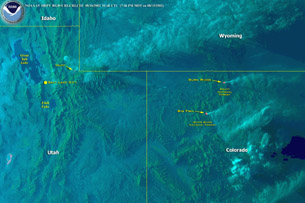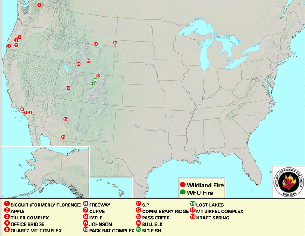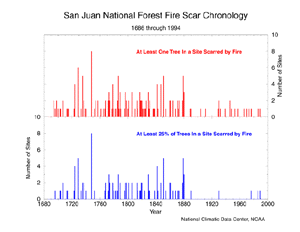Continuing dry conditions in the western U.S. further fueled the wildfires in August. Though the fire activity lessened somewhat during August, as of the beginning of September (according to the National Interagency Fire Center), there were well over 6 million acres burned this year. The (ten-year) average number of acres burned by the same date is approximately 3.2 million acres. However for the first month this year, there were fewer cumulative seasonal acres burned than during the very intense wildfire season of 2000 (see table below).
Some of the contiguous states which have suffered the most acreage destroyed by wildfire include Arizona (nearly 650,000 acres), Colorado (~506,000 acres) and Oregon (~992,500 acres), all as of the end of August. While some of this year's fires were started by accident or arson, many were started by lightning, as was the case in Oregon's Sour Biscuit Fire which continued to burn through August. Most of the large fires in August occurred in Oregon, California, Colorado, Wyoming and Arizona. Further information on this year's fire season can be found at the National Interagency Fire Center's web-site.
| By State | Approximate Number of Acres Burned, as of September 3, 2002 |
|---|---|
| Alaska | 2,191,280 |
| Arizona | 649,020 |
| California | 426,496 |
| Colorado | 505,915 |
| Idaho | 67,576 |
| Nevada | 81,365 |
| New Mexico | 308,244 |
| Oregon | 992,475 |
| Utah | 261,930 |
| Wyoming | 76,208 |
| As of September 3 | Nationwide Number of Fires | Nationwide Number of Acres Burned |
|---|---|---|
| 2002 | 62,924 | 6,330,440 |
| 2001 | 58,545 | 2,945,049 |
| 2000 | 74,180 | 6,524,274 |
| 10-year Average | 64,129 | 3,223,813 |
The graph to the right shows the fire scar chronology for the San Juan National Forest in the southern San Jaun Mountains of Colorado from 1686 through 1994. Scars have been collected at nine sites, and at each site numerous scarred trees were sampled. The top graph shows the number of sites each year that experienced fire, where at least one tree in the site exhibited fire scarring. The bottom graph shows the number of sites each year that experienced widespread fire, where at least 25% of the trees in a site exhibited fire scarring. The graphs indicate that fires are a natural part of the forest cycle in southern Colorado. The hiatus in fires circa 1750-1770 is likely climatically related, but the lack of fires during the 20th century is very likely due to fire suppression and changing land use management practices. (This data supplied by Dr. Henri D. Grissino-Mayer and based on research by him and colleagues William H. Romme, Lisa Floyd-Hanna, and David Hanna.)
 NOAA's National Centers for Environmental Information
NOAA's National Centers for Environmental Information


